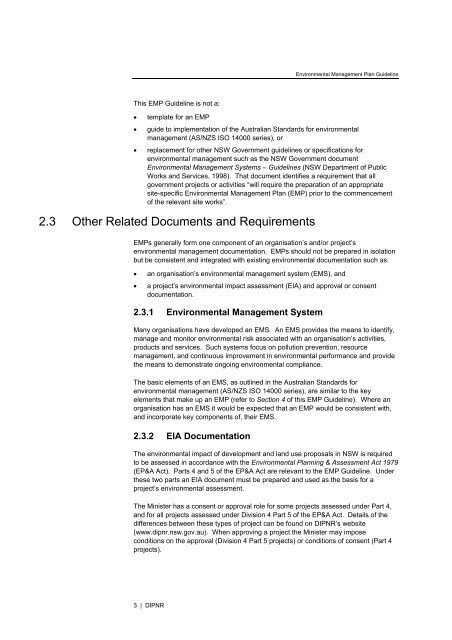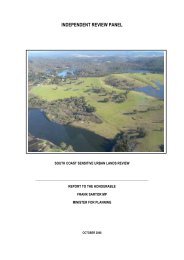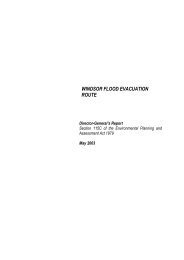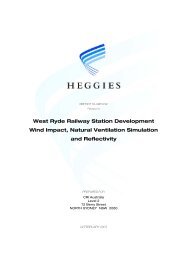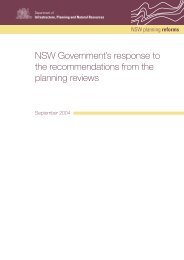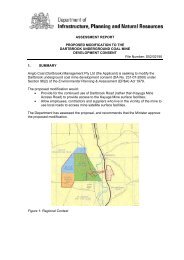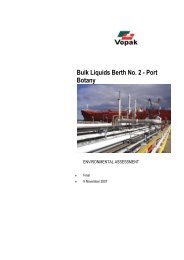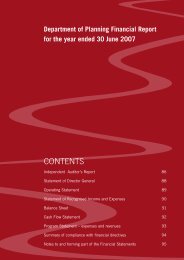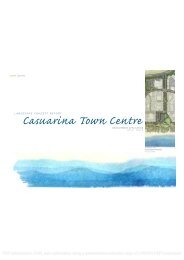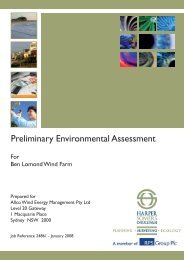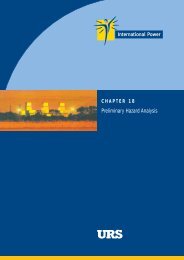Guideline for the Preparation of Environmental Management Plans
Guideline for the Preparation of Environmental Management Plans
Guideline for the Preparation of Environmental Management Plans
Create successful ePaper yourself
Turn your PDF publications into a flip-book with our unique Google optimized e-Paper software.
<strong>Environmental</strong> <strong>Management</strong> Plan <strong>Guideline</strong><br />
This EMP <strong>Guideline</strong> is not a:<br />
• template <strong>for</strong> an EMP<br />
• guide to implementation <strong>of</strong> <strong>the</strong> Australian Standards <strong>for</strong> environmental<br />
management (AS/NZS ISO 14000 series), or<br />
• replacement <strong>for</strong> o<strong>the</strong>r NSW Government guidelines or specifications <strong>for</strong><br />
environmental management such as <strong>the</strong> NSW Government document<br />
<strong>Environmental</strong> <strong>Management</strong> Systems – <strong>Guideline</strong>s (NSW Department <strong>of</strong> Public<br />
Works and Services, 1998). That document identifies a requirement that all<br />
government projects or activities “will require <strong>the</strong> preparation <strong>of</strong> an appropriate<br />
site-specific <strong>Environmental</strong> <strong>Management</strong> Plan (EMP) prior to <strong>the</strong> commencement<br />
<strong>of</strong> <strong>the</strong> relevant site works”.<br />
2.3 O<strong>the</strong>r Related Documents and Requirements<br />
EMPs generally <strong>for</strong>m one component <strong>of</strong> an organisation’s and/or project’s<br />
environmental management documentation. EMPs should not be prepared in isolation<br />
but be consistent and integrated with existing environmental documentation such as:<br />
• an organisation’s environmental management system (EMS), and<br />
• a project’s environmental impact assessment (EIA) and approval or consent<br />
documentation.<br />
2.3.1 <strong>Environmental</strong> <strong>Management</strong> System<br />
Many organisations have developed an EMS. An EMS provides <strong>the</strong> means to identify,<br />
manage and monitor environmental risk associated with an organisation’s activities,<br />
products and services. Such systems focus on pollution prevention, resource<br />
management, and continuous improvement in environmental per<strong>for</strong>mance and provide<br />
<strong>the</strong> means to demonstrate ongoing environmental compliance.<br />
The basic elements <strong>of</strong> an EMS, as outlined in <strong>the</strong> Australian Standards <strong>for</strong><br />
environmental management (AS/NZS ISO 14000 series), are similar to <strong>the</strong> key<br />
elements that make up an EMP (refer to Section 4 <strong>of</strong> this EMP <strong>Guideline</strong>). Where an<br />
organisation has an EMS it would be expected that an EMP would be consistent with,<br />
and incorporate key components <strong>of</strong>, <strong>the</strong>ir EMS.<br />
2.3.2 EIA Documentation<br />
The environmental impact <strong>of</strong> development and land use proposals in NSW is required<br />
to be assessed in accordance with <strong>the</strong> <strong>Environmental</strong> Planning & Assessment Act 1979<br />
(EP&A Act). Parts 4 and 5 <strong>of</strong> <strong>the</strong> EP&A Act are relevant to <strong>the</strong> EMP <strong>Guideline</strong>. Under<br />
<strong>the</strong>se two parts an EIA document must be prepared and used as <strong>the</strong> basis <strong>for</strong> a<br />
project’s environmental assessment.<br />
The Minister has a consent or approval role <strong>for</strong> some projects assessed under Part 4,<br />
and <strong>for</strong> all projects assessed under Division 4 Part 5 <strong>of</strong> <strong>the</strong> EP&A Act. Details <strong>of</strong> <strong>the</strong><br />
differences between <strong>the</strong>se types <strong>of</strong> project can be found on DIPNR’s website<br />
(www.dipnr.nsw.gov.au). When approving a project <strong>the</strong> Minister may impose<br />
conditions on <strong>the</strong> approval (Division 4 Part 5 projects) or conditions <strong>of</strong> consent (Part 4<br />
projects).<br />
3 | DIPNR


